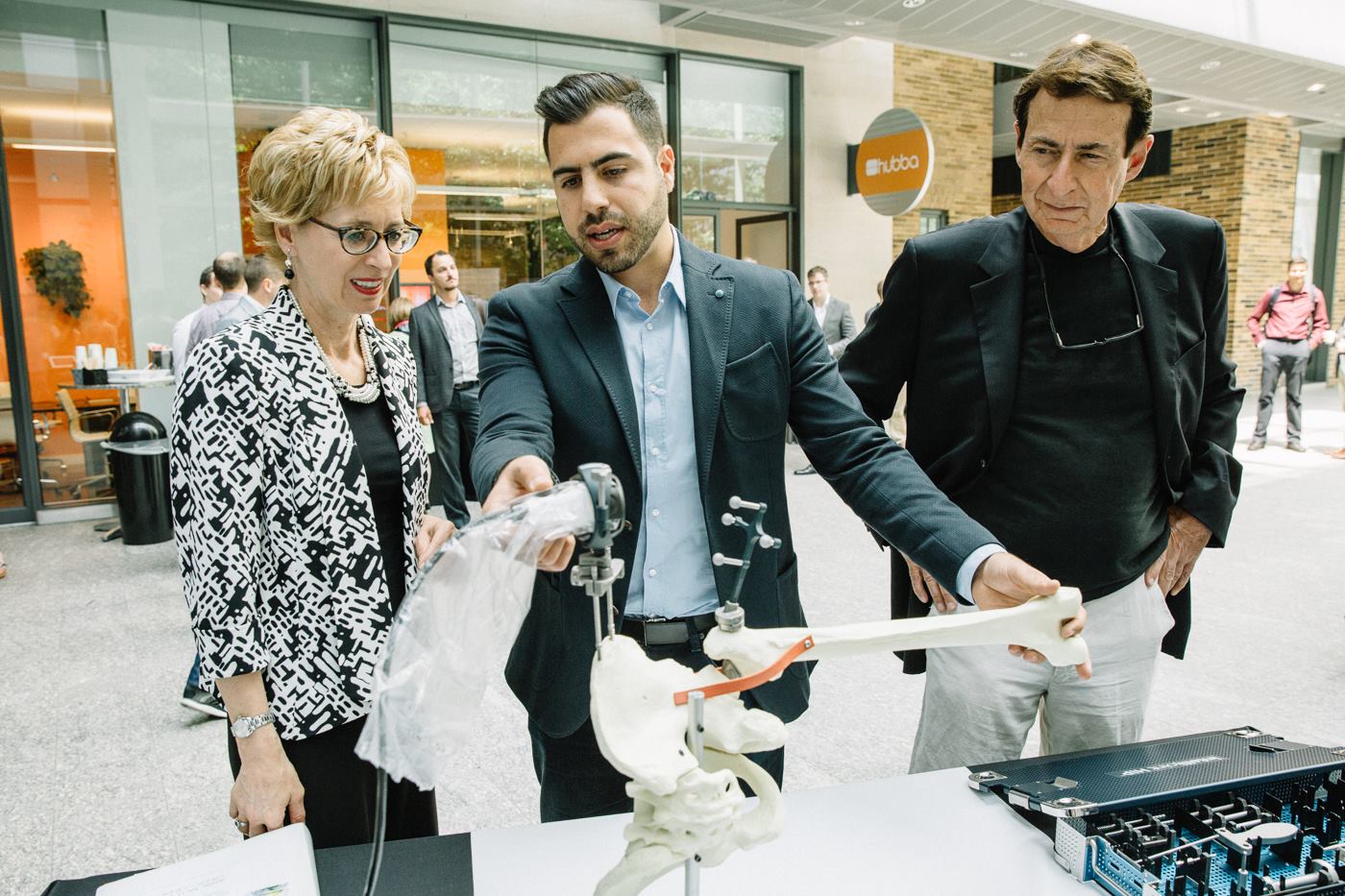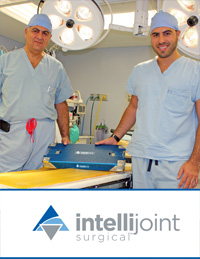Developing innovative solutions to common medical problems
Written By: Emily Innes
Produced By: Tom Cunningham
The founders of Intellijoint Surgical had one criterion for their final year engineering project at the University of Waterloo in Ontario: develop something novel.
Armen Bakirtzian, Richard Fanson, and Andre Hladio successfully accomplished this in 2007 with their invention of a medical smart tool, intellijoint HIPTM. The device consists of miniature sensors that assist surgeons in the accurate selection and alignment of implants during hip replacement surgery.
“I was doing an option in biomechanics that required a bio-related fourth year design project…luckily I have an orthopaedic surgeon for a father who introduced me to an unsolved problem, ” said Bakirtzian, CEO and director of Intellijoint Surgical. “I went to watch a hip replacement with my father and he explained very clearly to me that when he does a hip replacement, similar to other orthopaedic surgeons, he selects and aligns the hip implant using his professional judgment and eyeballing. Unfortunately, they are subject to making mistakes.”
Upon further investigation, he and his colleagues discovered that 95 per cent of surgeons in North America do not use any tools to assist them with implant selection and alignment during hip replacement surgery.
Hip replacement surgery has high dissatisfaction rates
Common problems that patients can experience after hip replacement surgery, which is done frequently on an annual basis, include leg length discrepancy where one leg can be longer than the other post-surgery. Research has found that 62 per cent of hip replacement patients’ legs are lengthened by about one centimetre on average. This problem can cause patients to experience nerve impairment, gait abnormalities, and lower back pain. It increases the risk for hip dislocation and can lead to patients undergoing revision surgery.
“It is a problem that applies to all stakeholders, from the patients who have to endure the pain and hardship, to the surgeons who are liable for making mistakes and have to correct them when the patients come back to the hospitals,” said Bakirtzian. “And ultimately the hospitals want to deliver the best possible care for their patients. They want to make sure that the patients are satisfied with their outcome and they are not going to come back for follow-up surgery or follow-up care. (Finally), obviously the payers who have to pay for all those follow-ups are motivated for the surgery (to be done) right the first time.”
While in early development, Bakirtzian and his co-founders discovered that navigation technology systems are on the market to address this same problem, but were inaccessible to the majority of orthopaedic surgeons and hospitals due to high upfront capital costs and the time they add to the procedure. Hip replacement surgery is typically around 60 minutes. It is not feasible for surgeons to use a system that could add 15 to 30 minutes to the procedure. Another drawback is that they are very complex to use.
“We had orthopaedic surgeons and trained engineers and they still did not want to spend the time to learn how to use the system because it was too complicated even for them,” said Bakirtzian.
Intellijoint works closely with surgeons
Trying to understand exactly what would appeal to an orthopaedic surgeon and what would meet their needs, Bakirtzian said that his team collaborated closely with clinicians.
“I think not only for medical technology, but technology products in general, first of all you need to have the motivation from the industry that you are solving a problem that people actually care about, so getting the clinician involved from the beginning is a critical step in developing and commercializing a product,” he said.
“During the entire design process we have been very particular about making sure that we have that constant communication with the clinicians and that we use their feedback to iterate the product and to ensure we are actually satisfying the user’s needs.”
Hitting the mark, in 2010 the team won the Next Top Young Entrepreneur Star-Up Pitch competition, received an initial round of investment, and they founded the company. In 2013, they received a U.S. patent and were awarded a Health Canada Medical Device License. In 2014, intellijoint HIP received clearance from the U.S. Food and Drug Administration for the use of intellijoint HIP in a surgery for the first time in the United States. Only a year later, in 2015, over 250 hip replacement surgeries have been completed using the medical device.
Each quarter brings new milestones
“Every time we near the end of a quarter I will go out to breakfast with my co-founders and I always say, ‘The next quarter is going to be so exciting . . . or it is going to be the most exciting yet’, and that continues to be true every time a quarter goes by. We hit new milestones each and every quarter,” said Bakirtzian.
The most recent milestone was approval from Health Canada, which allows their core product to be launched commercially in Canada.
Bakirtzian believes that it is in part due to the company’s impressive team members that they have attracted positive attention. Another member of the management team is Eric Ryterski, the co-founder and former director of product development of Medtronic’s surgical navigation division. Surgeons have used Ryterski’s products to treat more than 500,000 orthopaedic and neurosurgery patients worldwide.
“At the end of the day our team is very strong, and from an investor’s point of view they invest in team first and concept second,” said Bakirtzian. “I think that is something we learned and understood in the early days and we built a strong team around us from advisors, to surgeons, to people in the industry who have done this before and this gives investors a lot of confidence.”
intellijoint HIP is only the beginning for Intellijoint Surgical as they have plans to develop innovative tools for other orthopaedic applications such as knee replacements, but also to expand to other medical specialties including neurosurgery and ear, nose, and throat (ENT). Their core technology has potential to offer benefits even beyond surgical applications.
“There is so much that our core technology can do and excel at,” added Bakirtzian. “Now that we have a commercial product on the market, our team is extremely excited to see all of the opportunities in front of us and where our core technology will be applied next.”
To learn more about Intellijoint Surgical, visit www.intellijointsurgical.com.







